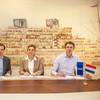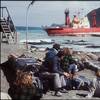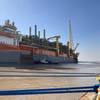It was supposed to be the world's largest artificial coral reef for scuba diving, located off the coast of Key Largo. More than eight years ago, a group of divers from the area devised a plan to sink a 510-ft. (155.4-m) retired Dock Landing Ship (LSD) to the bottom of 130 ft (39.6 m). of water. For the next several years, Spiegel Grove became Key Largo Chamber of Commerce's pet project. With various local dive shops, businesses and dedicated individuals participating in this venture, the vessel, which had been decommissioned in 1989, was towed last June from the James River Reserve Fleet, to a shipyard in Portsmouth, Va., so that workers could ready the vessel for its intentional sinking. With work stopping abruptly when funds were low, things started up again this past January when Spiegel Grove was towed to Chesapeake, Va. to its new contractor, which finished up the job. With all going along as planned the Chamber of Commerce was thrown a curve on May 17, when the vessel, which had been brought down to Key Largo just weeks before for its final preparation — began sinking just a few hours before it was to be intentionally sunk.
By Regina P. Ciardiello, managing editor
When the panic began to subside, the Key Largo Chamber of Commerce feared that professional help to get this vessel back on its side was going to be expensive and time-consuming. The Organization's fears were soon eased when it enlisted the help of Port Everglades, Fla.-based Resolve Marine Group.
When Spiegel Grove sank prematurely and landed upside-down, Resolve received the call and immediately dispatched salvage master Frank Leckey, and salvage engineer Todd Schauer to the scene. The two assessed the situation, spending the evening compiling engineering data, Resolve was informed at approximately 10 p.m. that night that the job was theirs. With the non-profit organization Key Largo Chamber of Commerce, price was a big factor in selecting a salvage team. According to Resolve's president, Joe Farrell, Jr. "We (Resolve Marine) don't take advantage of other people's misfortunes," he said. "We're there to do a job."
While the new contract may have been cause for celebration at Resolve, there was no time, as hard work and research was required immediately — a 510-ft. (155.4-m) vessel had to be righted and sunk down to 130-ft. (39.6 m) of water. "It was a challenging job," Farrell said. "We had to really give everything a hard look before we went in there. This was probably one of the toughest salvage jobs we've ever pulled off."
Experience Pays Off
Resolve is no stranger to participating in jobs under the media microscope — and this was no different. The company has participated in other high-profile jobs such as the Value Jet recovery and assistance in 1996, and provided aid to vessels in need during Hurricane Andrew in 1992.
With daily updates via news outlets from CNN to the local Florida news broadcasts, Resolve became known as the company that had a seemingly impossible task. Following a helicopter survey flight and prior to the initial presentation to the Key Largo Chamber of Commerce, Schauer and Leckey had to devise a salvage plan that would not only work — but would be affordable as well. According to Schauer, his confidence lied mainly upon his own knowledge and just a pure "gut feeling" that the plan would work, but he also realized that a significant amount of engineering would still be required.
After going through all the initial data and running all the numbers back at Resolve's Port Everglades headquarters, the company decided what types of equipment, and how much, would be used for the job.
"We first had to assess the amount of compressed air and lift bags we would need, as well as the types and locations of tanks we would use for air," Schauer said. "We also had to figure out the angle that we would roll the vessel to be successful - before we even got there." Farrell said that the sinking part did not worry him, since LSD ships, which resemble a large parking garage — able to hold landing and hover craft — "are designed to be sunk."
Sinking and Thereafter
Following the initial sinking attempt, Spiegel Grove ended up with its bow pointing towards the Florida sky. The stern of the vessel began to slip beneath the ocean prematurely — while an excessive amount of air remained in the bow. As the stern sank and the bow raised up, the water rushing in created an imbalance with the air trapped inside, causing it to roll starboard. The vessel then came to rest upside-down with the stern laying on the ocean floor and the bow protruding above the ocean's surface due to air still trapped inside the hull.
Since Spiegel Grove had been thoroughly prepared for sinking as an artificial reef by cutting large holes throughout its superstructure and hull, there was very little buoyancy remaining in the wreck that would assist the salvors in righting the vessel. Thus, the salvage team, which was stationed alongside Spiegel Grove from its salvage vessel, Lana Rose, decided to cut anchor holes on the port side in order to attach approximately 70 airbags, which would aid in the lifting of the vessel. With the largest of the inflated airbags measuring 25 ft. and able to lift 25 tons, air was then pumped into the vessel's off-center ballast tanks so that it could be rolled over. Numerous compressors and manifolds were utilized onboard Lana Rose and were connected to the wreck via a complex bundle of air lines (more than 10,000 ft. of hose) to deliver more than 2,000 tons of buoyancy into one side of the vessel to assist in the roll.
In addition to the Lana Rose, two other tugs assisted with the raising, American Patriot, and Smith Maritime's 5,000-hp triple screw tug, Elsbeth III, which were attached to Spiegel Grove via steel cable and heavy hawsers rolling the ship upright.
According to Farrell, the righting of the vessel seemed like the longest five minutes of his life. Once the vessel disappeared beneath the surface, Farrell was watching from the Lana Rose — trying to figure out what angle Spiegel Grove was at. Farrell describes what was probably the most poignant moment of the job: "We didn't know what angle she (Spiegel Grove) was at," Farrell said. "But as soon as we saw (from the Lana Rose), the three-ft. bubbles boiling from the water's surface — that's when we knew we had it. That the vessel had rolled over and dumped the air out of its sides."
Currently, Spiegel Grove lies beneath the sea on its starboard side. Not the original plan that was intended but one that has proven beneficial for the Key Largo Chamber of Commerce and the recreational divers who plan to explore the vessel. According to Todd Schauer ,there are benefits to it being on its side. "Since the ship is on its side, more of it is available to novice divers in the 40 to 50-ft. depth range." Schauer added that divers can also view items that they normally would not see if the ship were upright, such as the vessel's propellers and lower hull. "It provides divers with a new perspective — they can see the entire ship," he said.
Resolve's Farrell has expressed his desire to work with Key Largo again, if and when they decide that they want to right the ship, which at a price upwards of $400,000, would encompass the use of barges with hydraulic lift frames with 2,000 tons of lift on one side.
For now though, it seems that divers don't mind that the vessel was not completely 'righted,' as it has been reported that the Chamber, in the weeks following the vessel's sinking, received an average of 2,000 inquiries — on diving the Spiegel Grove.
Subscribe for
Maritime Reporter E-News
Maritime Reporter E-News is the maritime industry's largest circulation and most authoritative ENews Service, delivered to your Email five times per week












